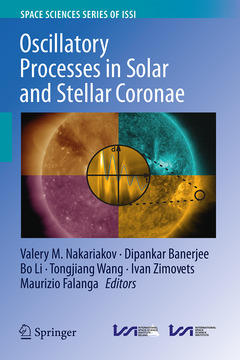Oscillatory Processes in Solar and Stellar Coronae, 1st ed. 2023 Space Sciences Series of ISSI Series, Vol. 76
Coordonnateurs : Nakariakov Valery M., Banerjee Dipankar, Li Bo, Wang Tongjiang, Zimovets Ivan, Falanga Maurizio

00 Editorial / Preface (book) (Editors: Nakariakov, V.M., et al.).- 01 MHD waves in open coronal structures (Banerjee, D., et al.).- 02 Kink oscillations of coronal loops (Nakariakov, V.M., et al.).- 03 Slow-Mode Magnetoacoustic Waves in Coronal Loops (Wang, T., et al.).- 04 Magnetohydrodynamic Fast Sausage Waves in the Solar Corona (Li, B. et al.,).- 05 Coronal heating by MHD waves (Van Doorsselaere, T., et al.).- 06 Quasi-periodic pulsations in solar and stellar flares: a review of underpinning physical mechanisms and their predicted observational signatures (Zimovets, I.V., et al.).- 07 Novel data analysis techniques in coronal seismology (Anfinogentov, S., et al.).
Professor Valery M Nakariakov graduated from the School of Radiophysics of Lobachevsky’s Gorky (now – Nizhny Novgorod) State University in 1989. He defended his PhD thesis in Plasma Physics at the Applied Physics Institute of RAS in 1993. The topic of his PhD research was theoretical modelling of the interaction of waves with plasma non-uniformities. In 1995-1999 he was a postdoc at the University of St Andrews, UK. In 1999, he became Lecturer (Full Professor from 2007) and Head of the Solar Physics team in the Physics Department of the University of Warwick, UK. His main area of research is related to the observational study and theoretical modelling of magnetohydrodynamic waves in plasma structures on the Sun's Corona, new methods of plasma diagnostics, radiophysics of the Sun, and quasi-periodic processes in solar and stellar flares. From 2011-2014, he served as President of the European Solar Physics Division of the European Physical Society. In 2015, he was honored by the Payne-Gaposchkin Medal and Prize of the Institute of Physics, UK.
Prof. Dipankar Banerjee is currently the director of the Aryabhatta Research Institute of Observational Sciences (ARIES), Nainital.Heis an astrophysicist with a bachelor’s degree in physics (St. Xavier’s college) and master’s degree in theoretical physics from University of Kolkata, India. He has obtained his PhD from Indian Institute of Astrophysics and completed two postdoctoral tenures in reputed institutions in Europe. He is the co-chair of the Science working group of the “Aditya” mission. Aditya is the first dedicated Indian mission to study the Sun, expected to be launched by ISRO around 2022. He is also the project coordinator for the National Large-Solar Telescope Project (NLST). NLST is a proposed 2-meter ground-based telescope planned to be installed at a Himalayan site. He is also involved with NASA’s PUNCH mission.Dr. Banerjee has more than 120 peer-reviewed publications with ar
Gives a comprehensive overview of oscillatory processes in solar and stellar coronae
Discusses observations made by primary instruments used to research solar and stellar phenomena
Contains review, analysis, and modelling of cutting-edge research in solar and stellar science
Date de parution : 01-2024
Ouvrage de 386 p.
15.5x23.5 cm
Date de parution : 01-2023
Ouvrage de 386 p.
15.5x23.5 cm



